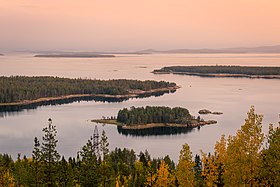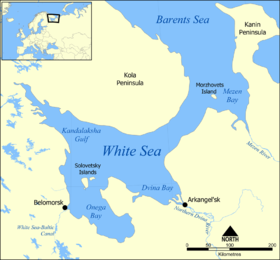
Back Golfu de Kandalakcha AST Кандалакша ҡултығы Bashkir Кандалакшскі заліў Byelorussian Кандалакшки залив Bulgarian Golf de Kandalakxa Catalan Kandalakshskiy Zaliv CEB Kandalakšský záliv Czech Kandalaksjabugten Danish Kandalakscha-Bucht German Golfo de Kandalakcha Spanish
| Kandalaksha Gulf | |
|---|---|
 Kandalaksha Gulf | |
 Kandalaksha Gulf: Northwest gulf of the White Sea | |
| Coordinates | 66°55′N 32°45′E / 66.917°N 32.750°E |
| Type | Gulf |
| Basin countries | Russia |
| Max. depth | 300 m (980 ft) |
| Official name | Kandalaksha Bay |
| Designated | 11 October 1976 |
| Reference no. | 110[1] |
The Kandalaksha Gulf (Russian: Кандалакшский залив, Skolt Sami: Käddluhtt, Finnish: Kantalahti) is located in the Republic of Karelia, and Murmansk Oblast in northwestern Russia. Forming the north-western corner of the White Sea, it is one of four large bays and gulfs of this sea, the others being the Onega Bay (south-west), the Dvina Bay (south), and the Mezen Bay (south east).[2]
The Kola Peninsula lies north of the Kandalaksha Gulf. The city of Kandalaksha is located at the northern tip of the gulf; the new oil port Vitino, some 10 km to the south. There are hundreds of skerries in the gulf. The gulf is shallow, reaching 300 meters on its western side. In 1976, the upper reaches of the gulf were designated a Ramsar wetland of international importance, notably as a breeding ground for migratory waterfowl such as the sea duck.[1]
Kandalaksha Nature Reserve (Кандалакшский заповедник) includes parts of the coastline and many of the islands in the gulf. It is one of Russia's oldest nature reserves, established in 1932.[3]

Since deglaciation the rate of post-glacial rebound in the Kandalaksha Gulf has varied. Since the White Sea connected to the World's oceans uplift along southern coast of the gulf has totaled 90 m. In the interval 9,500–5,000 years ago uplift rate was of 9–13 mm/yr. Prior to the Atlantic period uplift rate had decreased to 5–5.5 mm/yr, to then rise briefly before arriving at the present uplift rate is of 4 mm/yr.[4]
- ^ a b "Kandalaksha Bay". Ramsar Sites Information Service. Retrieved 25 April 2018.
- ^ "Kandalaksha State Nature Reserve". Kandalaksha State Nature Reserve (Official Site) (in Russian). Ministry of Natural Resources and Ecology of the Russian Federation. Retrieved 29 May 2016.
- ^ "Kandalaksha Zapovednik". State Nature Reserves of Russia (in Russian). Ministry of Natural Resources and Ecology of the Russian Federation. Retrieved 29 May 2016.
- ^ Romanenko, F.A.; Shilova, O.S. (2011). "The Postglacial Uplift of the Karelian Coast of the White Sea according to Radiocarbon and Diatom Analyses of Lacustrine-Boggy Deposits of Kindo Peninsula". Doklady Earth Sciences. 442 (2): 544–548. doi:10.1134/S1028334X12020079.
